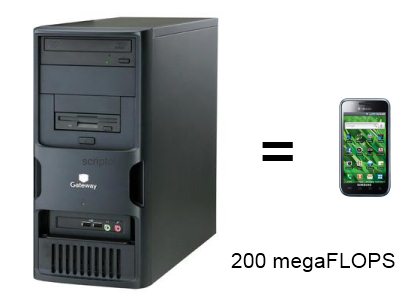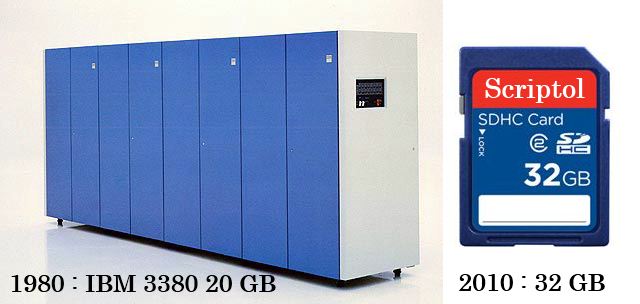Computer History
Several successive inventions have been necessary before computer become possible...
Let start with a definition of a computer:
An electronic device which is capable of receiving information (data) in a particular form and of performing a sequence of operations in accordance with a predetermined but variable set of procedural instructions (program) to produce a result in the form of information or signals. (Oxford Dictionary)
Electronic, magnetic, optical, electrochemical, or other high speed data processing device performing logical, arithmetic, or storage functions. (US Penal Code 7-33-4 ).
Both definitions includes smartphones and tablet PC.
Inventions
Abacus. Invented by ancient chinese.
The clock. Bolter credits the invention of the weight-driven clock as the key invention of Europe in the Middle ages, in particular the verge escapement that provides us with the tick and tock of a mechanical clock. This led immediately to mechanical automata beginning in the thirteenth century.
Pascaline, first calculator by Blaise Pascal.
Jacquard loom (1801). It led to the revolt of the Luddites.
Ticker tape (late 1800).
The telegraph, (mid-1800) is the precursor of the telephone.
Difference Engine from Babbage (1821). First computer language designed with Ada Lovelace.
Hollerith cards (punch cards, 1887).
Teletype (1910).
Electromechanical relays (1935). With its two "binary states" open and closed.
Digital, binary adding device (1937) by George Stibitz based after relays.
Claude Shannon in a thesis at MIT shows how to implement Boolean algebra using electronic relays and switches (1937).
Baudot code encoding on tape.
EDVAC design. Implementing architecture of Von Neumann.
Magnetic core memory (1954).
Microprogramming (1955) now called firmware. By Maurice Wilkes. Base set of instructions extended by program.
Magnetic disc (1956). Introduced by IBM, called RAMAC.
Integrated circuit. Starts the third generation of computers in 1960s.
Computers
The Antikythera mechanism. Built in 87 BC, this computer was able to predict the astronomical positions. A functional replica was built today (video).
Analog computers. (Before 1940).
Model K, by Georges Stiblitz was a relay-based computer (1937).
Z series by Konrad Zuse. Z1 in 1936. It used several rooms of the house of his parents.
Atanasoff-Berry (1938) specialized computer for solving linear equations.
Harvard Mark I (1939). By IBM, decimal arithmetic as Babbage's engine.

Z3. German Museum, Munich
Z3 (1941) By Konrad Zuse. Floating-point, binary. Turing-complete. Zuse's patents were bought by IBM.
Colossus (1943). Used to break codes.
ENIAC (1945). Electronic Numerical Integrator and Computer. A digital computer, by the university of Pennsylvania. Turing-complete.
EDSAC (1949). By University of Cambridge. First to implement the Von Neuman architecture. Program and data are in a same store.
EDVAC. Electronic Discrete Variable Automatic Computer, successor to ENIAC (not EDSAC).
Ferranti Mark I (1951). University of Manchester.
UNIVAC I (1951). Universal Automatic Computer. Par Remington Rand.
IBM 701 (1952). First mainframe.
IBM 704 (1954). Introduced magnetic core memory.

Next computer
Micro-processor (1971).
The Intel 4004, 4 bits, appeared in 1971. The first 8 bits, Intel 8008 appears in 1972. The popular 8080 in 1974.
MOS 6502 microprocessor (1975). The cheap processor, $ 25 against $ 300 for the Motorola 6800 (1974) opens the way for microcomputers.
Micro-computers. How invented them? Some appeared with KIM 1, Altair 8800, Apple 1 (1976).
They become popular in 1977 with Apple II, TRS-80 and commodore Pet.
The IBM PC in 1981 launched the success of micro-computer for business.
In 1982 Commodore released the C-64, a best-selling 22 million units.
The second commercial computer with GUI, after the failure of the Lisa in 1983, the Macintosh appears in January 1984. It is imitated by the Atari ST and Amiga in 1985, with color screens.
The NeXT Cube was far ahead of its time. and the NeXTStep operating system will become that of Apple with the return of Steve Jobs in 1997. In 1988, the interface already has the sidebar icons which will come on Ubuntu over 20 years later!
In 1994 devices combine the possibilities of phonie and those of a personal assistant. With an operating system, they are miniature mobile computer. The term smartphone appears in 1997.
Windows will adopt the GUI in 1995.
In 2008, the iPhone popularized the smartphone to the masses: the mobile phone can run applications, it is a computer.
In 2010, tablets are becoming popular thanks to the iPad, another idea of Steve Jobs. This is the beginning of the slow decline of the desktop for individuals. However tablets are a tool for consumption and does not replace entirely the desktop which is a production tool.
First personal computers
- 1974. Altair 8800 from MITS. with an Intel 8080 processor.
- 1977.
Apple ][ with color screen. Processor MOS 6502. 280x192 pixels graphic screen or 40x24 characters.
Radio Shack TRS-80. Monochrome. Zilog Z80 processor, clone of the 8080.
Commodore PET, 6502 processor. Monochome. - 1978. The Apple II got a hard drive.
- 1979. Acorn System 75.
- 1980. Z80.
- 1981.
IBM PC 5150 with Intel 8088. Low res CGA graphic scrren.
Commodore VIC 20. - 1982. Commodore 64, similar to the Apple II, but the screen resolution 320x200. Processor 6502 version 6510/8500.
- 1983.
Apple Lisa.
1984. Apple MacIntosh. - 1985.
Amiga de Commodore avec processeur 68000.
Atari ST avec le même processeur.
Evolution of the size of desktop computers from 1981 to 2014

According to the results achieved with this Linpack benchmark, in 2011 the speed of the Top 10 smartphones is over 200 megaFLOPS.
According to benchmarks for desktop computers this is equivalent to a computer with a 2 Ghz Pentium 4 in 2006.

Modern smartphone that is held in the hand has the same power as a Gateway E 2500 from 2006 powered by a Pentium 4.
The Tegra 3 from NVidia is a five cores processor offering performances similar to that of PCs. It is claimed to reach 300 megaFLOPS. Actually it integrates a 12 cores GPU ables to run 3D games.
We can say that there is such a blockage in the evolution of the size of computers. However, there was an attempt by Intel with Nuc to reduce the size of the PC and it turns out that this is the only type of desktop computer whose sales are up in 2014.
Evolution of storage

The storage unit IBM 3380 could contain 2.5 GB of data. Combining eight of them, you got 20 GB for a whole weighing 2 tons. It then cost $ 100 000.
Today (in 2010) we get 32 GB on an SD card with a weight of 1 gram and worth a hundred dollars! In Fébruary 2014 a 128 GB micro SD card is marketed.
See also...

